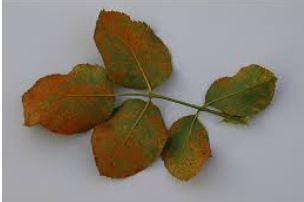
“Red rust of tea” is caused by parasitic
(a)Algae
(b)Fungi
(c)Bacteria
(d)Bryophyte
Answer
582.3k+ views
Hint: Red rust is an important disease of the tea plant in which orange-brown, velvety spots develop on the leaves of infected plants.
Complete answer : Red rust disease of tea is caused by algae of the genus Cephaleuros. Cephaleuros is a genus of parasitic simple green algae consisting of fourteen species. Its common name is red rust. Hence the disease caused by it is termed as red rust disease. The alga is parasitic on a few significant economic plants of tropical and subtropical types such as tea, coffee, mango, and guava. The disease causes damage which is limited to the area of algal growth on leaves, or destroying new shoots, or deforming fruit. Infections begin when a spore of the algae lands on the plant surface, germinates, and then penetrates its host.
Treatment:
-Use rust-resistant plant varieties when available.
-Pluck off and immediately burn infected leaves and regularly rake under plants to clean all fallen debris.
-Water during the early morning periods to allow the plants to dry out during the day to prevent infection.
-Use copper sprays or sulfur powders to inhibit the infection of susceptible plants. For best results, administer at the first sign of disease. Spray all plant parts completely and repeat the cycle every 7-10 days till the day of harvest.
-Burn infected plants after the growing season and do not compost.
So, the correct answer is “algae”.
Notes: Phenological studies showed that the frequency of the disease changed in different biological niches in the tea ecosystem. The factors determining its dominance were observed to be: the topography of plantation, jats or clones of tea, life and strength of the plant, and other environmental conditions.

Complete answer : Red rust disease of tea is caused by algae of the genus Cephaleuros. Cephaleuros is a genus of parasitic simple green algae consisting of fourteen species. Its common name is red rust. Hence the disease caused by it is termed as red rust disease. The alga is parasitic on a few significant economic plants of tropical and subtropical types such as tea, coffee, mango, and guava. The disease causes damage which is limited to the area of algal growth on leaves, or destroying new shoots, or deforming fruit. Infections begin when a spore of the algae lands on the plant surface, germinates, and then penetrates its host.
Treatment:
-Use rust-resistant plant varieties when available.
-Pluck off and immediately burn infected leaves and regularly rake under plants to clean all fallen debris.
-Water during the early morning periods to allow the plants to dry out during the day to prevent infection.
-Use copper sprays or sulfur powders to inhibit the infection of susceptible plants. For best results, administer at the first sign of disease. Spray all plant parts completely and repeat the cycle every 7-10 days till the day of harvest.
-Burn infected plants after the growing season and do not compost.
So, the correct answer is “algae”.
Notes: Phenological studies showed that the frequency of the disease changed in different biological niches in the tea ecosystem. The factors determining its dominance were observed to be: the topography of plantation, jats or clones of tea, life and strength of the plant, and other environmental conditions.

Recently Updated Pages
Master Class 10 General Knowledge: Engaging Questions & Answers for Success

Master Class 10 Science: Engaging Questions & Answers for Success

Master Class 10 Social Science: Engaging Questions & Answers for Success

Master Class 10 Maths: Engaging Questions & Answers for Success

Master Class 10 English: Engaging Questions & Answers for Success

Master Class 10 Computer Science: Engaging Questions & Answers for Success

Trending doubts
What is BLO What is the full form of BLO class 8 social science CBSE

Citizens of India can vote at the age of A 18 years class 8 social science CBSE

Full form of STD, ISD and PCO

Right to vote is a AFundamental Right BFundamental class 8 social science CBSE

Summary of the poem Where the Mind is Without Fear class 8 english CBSE

What are gulf countries and why they are called Gulf class 8 social science CBSE




